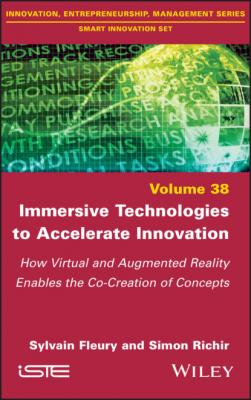Immersive Technologies to Accelerate Innovation. Simon Richir
Читать онлайн.| Название | Immersive Technologies to Accelerate Innovation |
|---|---|
| Автор произведения | Simon Richir |
| Жанр | Экономика |
| Серия | |
| Издательство | Экономика |
| Год выпуска | 0 |
| isbn | 9781119887287 |
In some cases, outside-in open innovation is not about generating ideas from expertise, but rather about having ideas selected by the community. For example, a company looking to quickly renew its product line can gather the community’s opinion to prioritize the products to be developed while being sure that they will meet consumer expectations.
1.3.2. The example of the MayAM challenge
For many years, our laboratory has organized the MayAM (for “Mayenne-Arts et Métiers”) open innovation challenge with groups of students from the Institut des Arts et Métiers de Laval specialized in immersive technologies. Each group of students is assigned an industrial company wishing to seize opportunities related to virtual and augmented reality technologies. They must then work for a week to imagine an innovative project for the company. The participating companies are part of an outside-in
1.3.3. Collaborative innovation
The organization of companies in silos often leads to a very low circulation of ideas. Also, beyond the exploitation of external resources, many companies under-exploit internal expertise. This is a form of open innovation, but rather thought at the level of a department, which we call collaborative innovation and which consists of making the circulation of ideas throughout the company more fluid by mobilizing the expertise of other departments.
1.3.4. Crowdsourcing
Crowdsourcing is one of the classic tools of outside-in
1.3.5. The lead user
The lead user concept was
Lead users have two important characteristics:
– they are ahead of the major trends in the evolution of uses and they recognize the needs before the others;
– they have an advantage and skills that lead them to innovate by themselves by developing the solution to their need.
Thus, lead users use prototypes to satisfy their needs before a commercial product can do so. In this sense, they are considered sources of innovation.
In theory, one might think that it is very easy to create radical innovations and always be one step ahead of the market by integrating lead users into the innovation process. In practice, we only know for sure that someone was ahead of the curve later on. Survivor syndrome, which is very common in the world of innovation, comes into play, giving us the opportunity to see the success of genius visionaries who “feel” the future and the evolutions to come. After the fact, it is safe to say that the founder of Oculus is a lead user and that the purchase of his company by Facebook to integrate it into its strategy is an illustrative success. It is a success, but let us not forget that it is because it was a success that this case is famous. In any case, lead users are often opinion leaders in their field because of their very strong expertise.
To identify lead users in a given field of activity, Von Hippel described a method called “pyramid”. It involves asking experts who they think are the best experts in the field, then going to them and asking the same question, and so on until you have a workable list of five or six names of people to interview who will be at the top. You have potentially got your hands on some lead users in your field! The next step is to analyze the usage of these few specialists and identify the types of technologies they use to meet the needs you want to address. If their usage leads you to other areas of expertise, you can then repeat the process of identifying lead users in these other areas of expertise.
1.4. Technical and human issues from ideation to design
The innovation process not only is based on methods but also relies on tools that can vary according to the type of project, its progress or the habits of the company.
Technology is the natural partner of the designer, especially when it comes to representing previously identified concepts. Indeed, most of the time, the digital representation tools are not mobilized during the ideation. The generation of ideas is classically carried out in textual form on Post-it notes or a paperboard, in the form of sketches, or by creating physical models with materials that are malleable or can be assembled such as modeling clay, cardboard or Lego (Dorta 2004). Computer-based 3D tools are usually reserved for later stages. In the design process, they are actually used to represent ideas that have already been selected and developed.
1.4.1. The sketch as a reflective process
After the very first phases of divergent ideation, the designer will use two types of “conversation”: a conversation with self and a conversation with co-designers and clients. Both types of conversation will require both visual representations and fluidity in the execution of the representation of the designer’s ideas.
The designer’s conversation with self refers to what Dorta (2004) calls reflection-in-action, which could be called a “reflective” conversation. In this process, the designer externalizes mental images, represents and represents again, producing new discoveries at each iteration that will lead to new ideas. They
